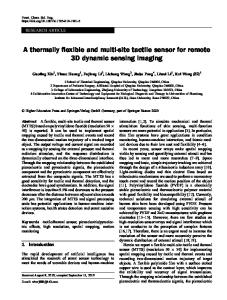Flexible Graphite as A Strain/stress Sensor
- PDF / 442,417 Bytes
- 6 Pages / 414.72 x 648 pts Page_size
- 74 Downloads / 359 Views
Mat. Res. Soc. Symp. Proc. Vol. 459 01997 Materials Research Society
Downloaded from https://www.cambridge.org/core. Access paid by the UCSB Libraries, on 08 Apr 2019 at 06:20:48, subject to the Cambridge Core terms of use, available at https://www.cambridge.org/core/terms. https://doi.org/10.1557/PROC-459-255
Sample
Flexible Graphite
Fig. 1 Set-up for strain/stress sensitivity testing.
EXPERIMENTAL Flexible graphite sheets (Grade GTB) of thicknesses 1.6 and 3.1 mm were provided by EGC Enterprises, Inc. (Mentor, Ohio). According to the manufacturer, the ash content is < 5.0%; the density is 1.1 g/cm 3 ; the tensile strength in the plane of the sheet is 5.2 MPa; the compressive strength (10% reduction) perpendicular to the sheet is 3.9 MPa; the thermal conductivity at 1093°C is 42 W/m.K in the plane of the sheet and 3 W/m.K perpendicular to the sheet; the coefficient of thermal expansion (CTE) (21-10930 C) is -0.4 x 10-6 C-' in the plane of the sheet. The electrical resistivity is 7.5 x 10' K2.cm in the plane of the sheet, as measured in this work by the four-probe method, using silver paint for the electrical contacts. This value is essentially the same as the value of 8 x 10' Q.cm given by the manufacturer. The electrical resistivity perpendicular to the sheet is 0.4 Q.cm according to the manufacturer. However our measurement using the four-probe method, with silver paint for the electrical contacts and with the two current probes in the form of loops on the opposite faces in the plane of the sheet and the two voltage probes in the form of dots at the centers of the loops, gave values of 0.011 ± 0.001 Q.cm for the sheet of thickness 1.6 mm (based on four samples cut from the sheet) and 0.037 ± 0.011 Q.cm for the sheet of thickness 3.1 mm (based on four samples cut from the sheet). The values obtained by our measurement rather than those given by the manufacturer were used in this work. The strain/stress sensing ability of flexible graphite was evaluated using the four-probe (A,B,C,D) set-up illustrated in Fig. 1. A rectangular piece of flexible graphite was sandwiched between two copper cylinders (diameter = 12.8 mm, height = 9.9 mm) labeled B and C in Fig. 1. Two larger pieces of flexible graphite cut from the original sheet (thus same thickness) as the abovementioned smaller piece were sandwiched between copper cylinders A and B and between copper cylinders C and D (Fig. 1). These larger pieces extended beyond the circumference of the copper cylinders, whereas the smaller piece was within the circumference. Silver paint was applied to the interface between each piece of flexible graphite and its adjacent copper cylinder. A copper wire was soldered to each of the four copper cylinders. The contacts to cylinders A and D were for current (DC) to pass through, whereas 256
Downloaded from https://www.cambridge.org/core. Access paid by the UCSB Libraries, on 08 Apr 2019 at 06:20:48, subject to the Cambridge Core terms of use, available at https://www.cambridge.org/core/terms. https://doi.org/10.1557/PROC-459-25
Data Loading...










